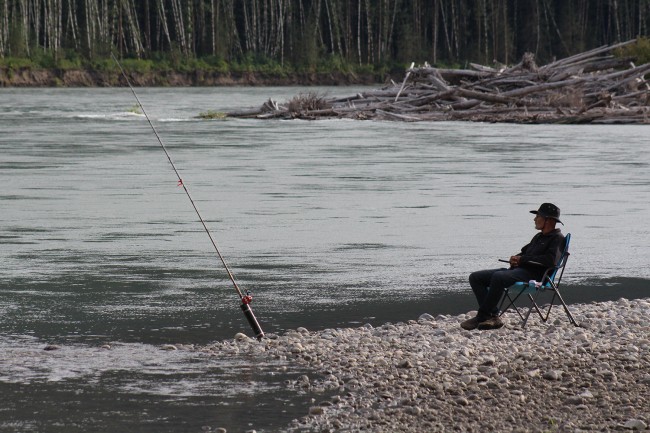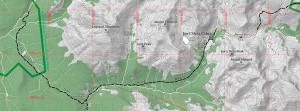
Photo Credit: Britta Boudreau
Fishing for Future
by Britta Boudreau
The day before the season opens, there is excitement on the river cut by a buzz of tension. July is traditionally the most productive month for Chinook; however, due to anticipated low returns of sockeye salmon, the Department of Fisheries and Oceans closed recreational fishing throughout the Skeena Watershed from June 15 to July 14 to allow First Nations, who traditionally harvest sockeye, to fish other varieties of salmon.
At dawn in mid-July, anglers arrive in campers and trucks, lowering boats into the water and loading them with gear—coolers overflowing with ice, camp stoves and propane, rods and reels, and Rubbermaid bins jammed with weights and lures—to ferry out to gravel bars, anxious to secure favourite fishing spots ahead of what is expected to be a busy opening day on the Skeena.
Two women from Saskatchewan loiter by the boat launch boldly asking strangers to serve as a guide. They’ve tried to find formal guides in Terrace, but can’t find an outfit that isn’t already booked for opening day. They either don’t realize or don’t care that guiding without a licence is illegal.
There is chatter among the anglers. How does the water look? Is it muddy or clear? Too fast? Too high? Is there excessive debris floating down?
What the fish are biting is a campfire debate steeped in tradition, personal preference, superstition, and secrecy. Whether or not there are fish is a more serious question with an even more complex answer.
Salmon science
The Department of Fisheries and Oceans calculates salmon odds like a Vegas bookie. Three times a day at the Skeena Tyee Test Fishery, upstream of commercial operations, gillnets are lowered into the water for exactly an hour. Scientists calculate escapement estimates for sockeye while determining relative abundance and timing for other species, including Chinook, by comparing the calculated indices for a given year to those recorded in previous years.
This is science, statistics, estimation, and a wild card of uncontrollable variables such as water temperature and turbidity all rolled together, but one piece of data is evident: salmon populations are not as robust as they once were.
While populations decrease, demand remains steady. Orca populations rely almost exclusively on Chinook salmon to meet exhaustive dietary needs. Commercial fisheries target Chinook—a salmon highly valued amongst the foodie community due to its rich flavour and high omega-3 fatty acids content—and recreational fishers favour the Chinook due to its large size. With the exception of the orcas, these groups mostly harvest spawning salmon before they have had a chance to spawn.
Jim Roberts, Fisheries Technician for Kitsumkalum Fish and Wildlife, says, “It’s not just one thing leading to lower populations. It is many factors combined: warming waters, different predators and different water conditions.”
Climate change has led to warmer, drier conditions resulting in an increase in forest fires that can destroy riparian zones and burn out root systems. The loss of foliage coverage can impact water temperature, run-offs, and substrate, producing less than ideal conditions for the fish.
Shrinking glaciers and loss of snowpack has resulted in reduced stream flows. Lower water levels make it difficult for returning salmon to reach spawning grounds and for juvenile fish to reach the ocean. Lower flows also mean the water warms faster, which is compounded by warming global temperatures and hotter summers. Higher water temperatures lead to physiological stress and depletion of energy reserves for the fish, making them more susceptible to predators, parasites and disease.
According to the Pacific Salmon Foundation, “Warm ocean conditions have also affected the marine ecosystem by changing the distributions and migrations of many species of fish, bringing predatory fish to British Columbia which are normally found off California, and changing the type of zooplankton at the base of the food web.”
As Roberts says, “With climate change and warming water temperatures, everything is changing and we need to do what we can to preserve what we can.”
The Big One
Opening day on the Skeena River isn’t warm; rather, it’s cold and wet. Elsewhere, wildfire is ripping across BC, and there is a province-wide campfire ban. I sit huddled in a winter jacket and tuque on the bank of the river. Eagles soar overhead, calling to each other in shrill raspy voices. A train rumbles by. A beaver navigates a logjam and a seal pops his head up casting an appraising eye to the shore. Hoping to catch The Big One, I’ve cast my line into the water with a soft plop: a 12-ounce weight sinks to the bottom, anchoring the line in place while the Spin-N-Glo lure whips around in the current. The rod is anchored in a holder with a small bell attached.
When a fish bites, the rod bends and jiggles and the bell rings. I run across the gravel to grab the rod and yank it, setting the hook. The fight is on. Keep the tension tight. Keep the tip of the rod up. Let the fish play himself out. When the fish takes off downstream, I panic and my thumb slides under the line which spools over it, slicing into me. The fish is tiring, but so am I. I work slowly to bring it back upstream, leading it close to shore. The fish has gone to the bottom of the river and isn’t moving.
Now it’s a waiting game. I keep the tension tight and when there is movement from the fish, I feel the slack and reel it closer to shore. My brother-in-law charges into the water with a net and on the third try scoops the salmon up. It’s not The Big One, but it is a personal record at 24 pounds.
I experience a twinge of guilt when I slit open the belly and see the orange roe, arranged in bunches like miniature grapes, representing thousands of eggs that won’t be deposited in a stream.
I fill the belly with ice and slip the fish into the cooler.
At dusk the Kitsumkalum survey boat beaches on the gravel bar in search of freshly-caught Chinook. Each summer for the past seven years, Kitsumkalum Fish and Wildlife monitors have traversed the Lower Skeena River interviewing recreational anglers and measuring and collecting scale samples. The study is conducted in partnership between Kitsumkalum First Nation and environmental research associates LGL Limited. As incentive to anglers to answer questions, the monitors hand out coveted ball caps.
The objectives of the data collection are to estimate monthly sport fishery catch of salmon across all species in the Skeena River downstream of Terrace, determine the ratio of wild and hatchery Chinook and collect length data and scales for age determination from Chinook salmon.
“It’s important to understand what the populations are at because we don’t want to lose the fish,” says Roberts. The 2016 report cautions, “The trend for increasing fishing effort observed over the last few years underpins the need to continue to monitor this fishery.”
Over the past seven years, Kitsumkalum fish monitors have developed an excellent relationship with recreational anglers. Participating in the interviews and providing samples is voluntary, but the anglers are enthusiastic to comply—not just for ball caps but because they recognize the monitors are there to help gather data in an effort to sustain fish populations.
For most recreational anglers, the goal is not really about sustenance. Filling the freezer is nice, but the real draw is the adventure. Each decision—which spot, which bait, which day—all add to the thrill. By the time I make the drive from Prince George, stop at McBike in Smithers for handfuls of Spin-N-Glo and in Terrace at Fish Tales for weights, line, hooks, and a few more lures, and load up on ice, my salmon carries a hefty per-pound price tag.
If salmon populations continue to decline, recreational fisheries will be the first to lose their allotment. It’s imperative to protect salmon populations which paradoxically means anglers must conserve salmon so they can continue to harvest salmon. “Everyone should have a fair share of the resources,” says Roberts, “but at the same time with the declining stock everyone should do their bit to conserve.”
It’s not impossible to imagine a future where recreational anglers have to enter a lottery—similar to the limited entry moose draw—to secure a salmon or two.
We pack up our gear and motor back to the boat launch. The area is buzzing with activity as satisfied and tired anglers leave the river. Others are just arriving, full of energy. Lugging the loaded cooler off the boat, I struggle under the weight as we pass two arriving fishermen. “Is it full of fish?” they ask hopefully. I give them a nod, and they smile happy to know that when they head out tomorrow and cast their lines they will have a fair chance at landing a fish, and maybe even a chance at landing The Big One.




Absolutely excellent writing! Its as though I was there.
👤 Jen HIgham 🕔 Sep 22, 2017